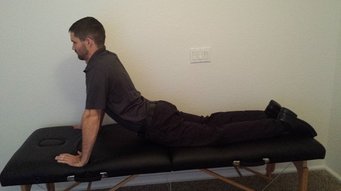- Home
- About Us
- TSPT Academy
- Online Courses
-
Resources
- Newsletter
- Business Minded Sports Physio Podcast
- Day in the Life of a Sports PT
- Residency Corner
-
Special Tests
>
-
Cervical Spine
>
- Alar Ligament Test
- Bakody's Sign
- Cervical Distraction Test
- Cervical Rotation Lateral Flexion Test
- Craniocervical Flexion Test (CCFT)
- Deep Neck Flexor Endurance Test
- Posterior-Anterior Segmental Mobility
- Segmental Mobility
- Sharp-Purser Test
- Spurling's Maneuver
- Transverse Ligament Test
- ULNT - Median
- ULNT - Radial
- ULNT - Ulnar
- Vertebral Artery Test
- Thoracic Spine >
-
Lumbar Spine/Sacroiliac Joint
>
- Active Sit-Up Test
- Alternate Gillet Test
- Crossed Straight Leg Raise Test
- Extensor Endurance Test
- FABER Test
- Fortin's Sign
- Gaenslen Test
- Gillet Test
- Gower's Sign
- Lumbar Quadrant Test
- POSH Test
- Posteroanterior Mobility
- Prone Knee Bend Test
- Prone Instability Test
- Resisted Abduction Test
- Sacral Clearing Test
- Seated Forward Flexion Test
- SIJ Compression/Distraction Test
- Slump Test
- Sphinx Test
- Spine Rotators & Multifidus Test
- Squish Test
- Standing Forward Flexion Test
- Straight Leg Raise Test
- Supine to Long Sit Test
-
Shoulder
>
- Active Compression Test
- Anterior Apprehension
- Biceps Load Test II
- Drop Arm Sign
- External Rotation Lag Sign
- Hawkins-Kennedy Impingement Sign
- Horizontal Adduction Test
- Internal Rotation Lag Sign
- Jobe Test
- Ludington's Test
- Neer Test
- Painful Arc Sign
- Pronated Load Test
- Resisted Supination External Rotation Test
- Speed's Test
- Posterior Apprehension
- Sulcus Sign
- Thoracic Outlet Tests >
- Yergason's Test
- Elbow >
- Wrist/Hand >
- Hip >
- Knee >
- Foot/Ankle >
-
Cervical Spine
>
- I want Financial Freedom
- I want Professional Growth
- I want Clinical Mastery
 Over the last few months, I have incorporated repeated motions into my exams and treatments more and more frequently. In fact, I probably prefer using these techniques prior to my manual treatments. More often than not; however, they are used in conjunction. Repeated motions are an excellent way to sustain any changes you might get with your manual treatments. The key to repeated motions is getting to end-range. With lumbar complaints, the majority of the time the patients will respond to repeated extension, either bilaterally or unilaterally. Typically, unilateral complaints respond to repeated sideglides (extension on involved side) and bilateral complaints respond to lumbar extension. There are a couple different ways to get to end-range: in a loaded position and an unloaded position. For extension, the options are standing lumbar extension and prone press-ups. In the past, the reason why I would choose loaded versus unloaded repeated motions was patient irritability. If a patient was unable to complete the loaded repeated motion due to irritability, an unloaded motion may be permitted as the tissues aren't as sensitive. Recently, I discovered another reason for switching to prone press-ups versus standing extensions. I had several patients that had reduction in symptoms with repeated standing extensions, but their symptom reduction plateaued. Upon examination of their technique with the backwards bending, I realized they were unable to get to end-range as the majority of motion was coming from the hips, even when using a table to block the thighs. I then reassessed the repeated motions with prone press-ups and the patients had significantly greater range and reduction in symptoms with the press-ups. This is a perfect example of a motor control issue that limits end-range. It can also be useful for patients with unilateral losses of extension. By shifting the shoulders to the involved side, prone press-ups can bias the side that has a loss of loading. If you find your patient's plateauing with upright repeated motions, try switching to a position that isolates the motion and allows end-range to be reached. -Chris
7 Comments
Molly Mostyn
12/29/2014 03:35:39 am
Do you have a resource about or would you be able to go more into depth about why repeated motions help with low back pain? Also are there times when you feel repeated motions aren't appropriate for low back pain?
Reply
Hi Molly,
Reply
Molly
1/2/2015 12:31:31 am
Thanks! I'll check it out!
Reply
Mike
12/29/2014 10:45:55 pm
It looks like your just replicating R.McKenzie's work, writing about it as if it's yours. Just an observation!
Reply
Hi Mike,
Reply
Craig
12/30/2014 10:03:07 am
Mike,
Reply
Alfred
1/19/2015 12:51:45 am
Do you by chance have a great way to improve motor control of the core THROUGH range of motions other than rolling or passive motions?
Reply
Leave a Reply. |
Dr. Brian Schwabe's NEW Book in partner with PaleoHacks!
Learn residency-level content on our
Insider Access pages We value quality PT education & CEU's. Click the MedBridge logo below for TSPT savings!Archives
July 2019
Categories
All
|






 RSS Feed
RSS Feed